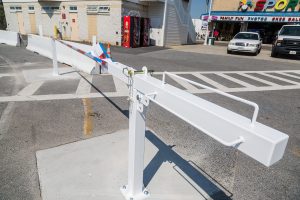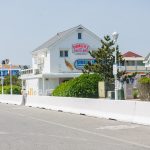
OCEAN CITY — After getting “sticker shocked” with the cost of the second phase of the Boardwalk access control plan, which came in estimated three or four times higher than anticipated, Ocean City officials this week sent the staff and designers back to the drawing board.
The Mayor and Council on Monday got an early look at the estimated cost of the second phase of the Boardwalk access control plan designed to tighten security and limit vehicular access. The first phase, which was implemented and installed prior to the start of this summer season, was a low-cost, stop-gap measure of sorts. The plan for the second phase is to install gates, some manual and some motorized, along with other barriers including bollards, planters and decorative concrete spheres at 26 locations up and down the Boardwalk and around the Inlet lot, City Engineer Terry McGean explained on Monday.
“Phase II of the project consists of permanent barriers more in keeping with the aesthetics of the Boardwalk along with heavy duty crash-rated manual and automatic gates,” he said. “There is a total of 26 locations along the Boardwalk excluding private property that need to be protected including the full length of the Inlet parking lot. All barriers and gates are crash-rated to prevent a medium-duty truck from penetrating the barrier and accessing the Boardwalk.”
However, the functional but aesthetically pleasing second phase came in with an estimated price tag considerably higher that what was first proposed at around $1 million.
“The cost of the project is currently estimated at $4.26 million, which is significantly higher than originally estimated,” said McGean. “The increase is attributed to higher costs associated with the barriers than originally anticipated, the need to protect the entire north and west border of the Inlet parking lot, the need to protect openings on private property and large uncertainties in the cost of construction material due to new and proposed tariffs. Cost reductions could be made by reducing the number of automated and manual gates, lowering the crash ratings of the materials, or using less-aesthetic materials such as railings or cable barriers.”
McGean provided a detailed presentation on the proposed Boardwalk access control project, which, as the name suggests, will tighten security at the numerous open access points along the famed promenade. After several events in the U.S. and around the world in which terrorists killed and injured dozens of victims by driving trucks and other large vehicles into large public areas where crowds gather, Ocean City officials last year began exploring ways to ramp up security in the form of vehicle access controls on the Boardwalk.
Naturally, unauthorized vehicles are not allowed on the Boardwalk, but there were dozens of access points where an ill-intending vehicle could reach it and its often-large crowds, particularly in the summer season. To that end, resort officials last year began exploring a series of permanent and semi-permanent barrier systems from gated access points that would allow police, fire and emergency vehicles along with the beach patrol, for example, to access the Boardwalk. In other areas, heavy planters or bollards could be used to prevent unauthorized vehicles from reaching the Boardwalk.
McGean’s presentation outlined the details for each access point along the Boardwalk and around the Inlet lot. There are 12 areas where gates could be installed, either manual or automated, and other areas where more permanent barriers will be installed. In most cases, those barriers would include crash-rated steel structures installed into the pavement, which would then be enshrouded with decorative concrete overlays. Some of the examples shown on Monday included planter boxes and even decorative concrete spheres over the steel business end of the structures.
The total estimated cost of phase two came in three to four times higher than what was anticipated.
“When you look at the cost by area, this includes the street ends and the Inlet lot,” he said. “It represents the high-end cost. It’s just over $4 million. These are much more than simply sticking a pipe in the ground. There is more to it than that.”
The Mayor and Council was naturally taken aback by the exorbitant cost-estimate and directed McGean and the project designer to go back to the drawing board to find ways to lower the cost.
“It was a little shock to see it come in three to four times higher,” said Councilman Dennis Dare. “This is a lot of money. I know it’s important, but we have a lot of other important issues.”
Mayor Rick Meehan suggested there could be some cost savings derived from reducing the number of gates, particularly the motorized gates that come with the higher price tag.
“The cost is more than anticipated,” he said. “If we do this, we want to do it right. That’s the number-one goal from the Mayor and Council’s standpoint. Maybe we can look at the areas where we need gates and the automated versus manual gates.”
McGean said that could be an option.
“There may be opportunities to reduce the number of powered gates which are considerably more expensive,” he said. “We understand the scope of this and we can go back and re-evaluate and make some changes.”
As far as the other barriers go, including the decorative bollards, planters and spheres, the cost could be lowered obviously, but it might come at the expense of aesthetics in and around the Boardwalk.
“We can look at alternative systems with lower costs, but there could be trade-offs,” he said. “There are systems that could be a little cheaper, but we might have to sacrifice aesthetics. We can get some cost savings, but it might sacrifice some of the goals. The Boardwalk has distinctive design and color patterns. Our goal is to make sure the barriers and gates match to the extent possible.”
What cannot, and likely should not, be sacrificed, however, are the crash ratings for the various structures. Dare asked about the specifications for the proposed barriers.
“It seems like the big thing is the crash rating,” he said. “Are we trying to stop a box truck that can reach 30 mph in a short distance?”
However, McGean said he would rather not discuss the proposed crash ratings in an effort to not divulge to much information about the barrier system.
“I prefer not to talk about the specifics of the crash ratings,” he said. “I prefer not to have that conversation in open session.”
Agreeing with that premise, Councilman Matt James at least wanted to know what the main objective of the project is for the town.
“What are we trying to accomplish?” he said. “If we’re just trying to keep vehicles off the Boardwalk, we could probably do something less expensive than trying to stop a vehicle from crashing into it.”
McGean’s presentation included detailed estimates on each type of barrier, from the automated and manual gates to the decorative bollards and planters. Councilman Wayne Hartman questioned if that was too much information considering the various elements will eventually be put out to bid.
“Why are we talking about costs when we’re going to put this out to bid?” he said. “It seems like we’re showing our cards.”
McGean explained because of the size and cost of the project, the estimates were included to allow the council to make an informed decision.
 “It’s considerably over the estimated $1 million and we thought it was important to show the estimates,” he said. “I don’t think we’re giving anything away given the magnitude of this. We’re trying to give you all of the information you need to make these decisions and there aren’t any secrets.”
“It’s considerably over the estimated $1 million and we thought it was important to show the estimates,” he said. “I don’t think we’re giving anything away given the magnitude of this. We’re trying to give you all of the information you need to make these decisions and there aren’t any secrets.”
Dare said the estimated $4.26 million price tag for phase two needed to be reworked to get that number down somehow.
“This needs to be value-engineered a little more,” he said. “My bottom line for tonight is the need for more value-engineering and come back with a plan. In my mind, we’re just really far apart on this right now.”
Hartman suggested the town could go back to the Worcester County Commissioners to seek funding assistance. The Mayor and Council asked Worcester County to assist with the cost of phase one during budget deliberations but were denied.
“Seeing the cost and sticker shock, it could be a good time to go back to the County Commissioners to ask for their help with our dilemma,” he said.

